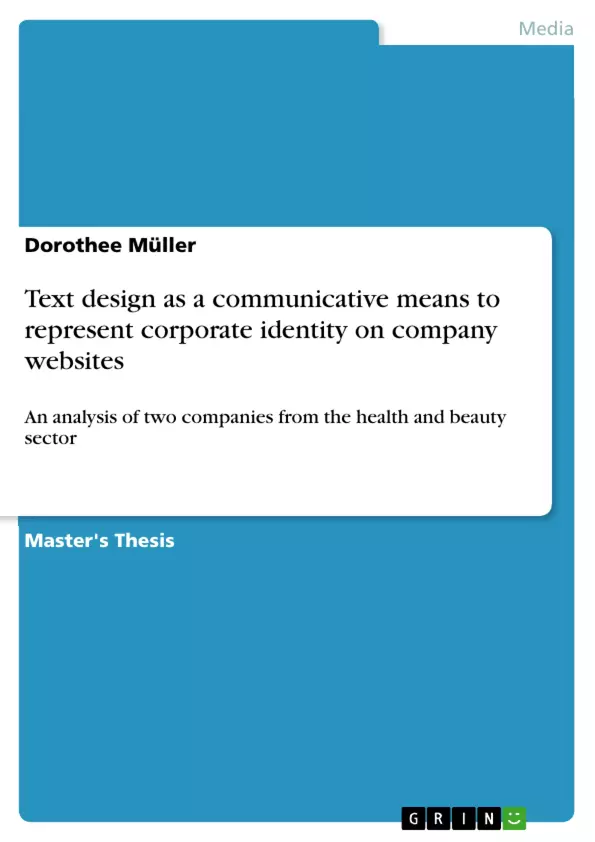Text design is a notion, which has so far not been investigated extensively in communication theory. However, or just because of that, it provides an interesting field of research. This dissertation focuses on the perspective of the communicator, the copywriter, who has to manage multimodal elements to achieve an inherently coherent design. Thereby an important part of business communication is included: the representation of corporate identity. Beiersdorf and L’Oréal are successful companies in the global health and beauty sector and are both market leaders in their respective countries. Using the example of their homepages, the main aim of this study is to show, how text design contributes to the purpose of image representation. Moreover, the perspective of the communicator is foregrounded, establishing a concept for copywriters to approach a text compilation process.
Under the aforementioned premise of showing to what extent text design features contribute to the purpose of presenting an intended image, the front pages of the two websites are analysed and compared. In order to initiate the analysis, a theoretical framework is constructed, which simultaneously serves two purposes: firstly, it is used as an analysing tool to approach the homepages in question and secondly, it is evaluated in order to ascertain whether or not this framework might be applied by professional copywriters in a text compilation process for websites.
The practical part shows that the intended image has a crucial impact on the way text is designed. The constructed framework proves useful as an analysing tool. However, the results emphasise that the focus in this project is far too narrow for practical implementation in a professional context. The outlook suggests an extension of the created framework in order to make it applicable as a supportive tool for copywriters.
Inhaltsverzeichnis (Table of Contents)
- Abstract
- Acknowledgments
- 1. Introduction
- 1.1 Rationale
- 1.2 The companies
- 1.3 Aims
- 1.4 Methodology
- 1.4.1 Literature review
- 1.4.2 Text design and its place in theory
- 1.4.3 Theoretical framework
- 1.4.4 Practical Analysis
- 1.5 Limitations of the study
- 2. Literature Review
- 2.1 Professional text production & text design
- 2.2 The role of the communicator
- 2.3 Audience analysis
- 2.4 Multimodal analysis
- 2.5 Design for electronic media
- 2.6 Visual Communication
- 2.7 Marketing & Corporate Identity
- 3. Text design and its place in theory
- 3.1 Clarification of terminology
- 3.2 Communication and linguistic theory
- 4. Establishing a theoretical framework
- 4.1 Audience analysis
- 4.2 Visual design
- 4.3 Use of Language
- 4.4 Dynamics
- 4.5 The reflection of corporate identity
- 5. Practical Analysis
- 5.1 The companies' explicitly stated philosophy
- 5.1.1 Beiersdorf
- 5.1.2 L'Oréal
- 5.2 Evaluation and Implications for the text design
- 5.3 Applying the framework
- 5.3.1 Beiersdorf Home
- 5.3.2 L'Oréal Home
- 5.1 The companies' explicitly stated philosophy
- 6. Evaluation
- 6.1 Findings of the analysis
- 6.2 Effectiveness of the theoretical framework
- 7. Conclusion & Outlook
Zielsetzung und Themenschwerpunkte (Objectives and Key Themes)
This dissertation investigates the role of text design in corporate communication, focusing on the perspective of the copywriter. The primary objective is to demonstrate how text design contributes to the representation of corporate identity, using the homepages of Beiersdorf and L'Oréal as case studies. Key themes explored in the dissertation include:- The importance of text design in conveying corporate image and philosophy.
- The role of the copywriter in managing multimodal elements to achieve coherent design.
- The application of a theoretical framework for analyzing and evaluating text design features on websites.
- The impact of audience analysis on the design and communication of corporate messages.
- The integration of visual and textual elements in creating a cohesive brand identity.
Zusammenfassung der Kapitel (Chapter Summaries)
The introduction establishes the rationale for this dissertation, outlining the author's interest in professional text production and the role of text design in corporate communication. It introduces the case studies of Beiersdorf and L'Oréal, outlining the study's aims and methodology. Chapter 2 presents a comprehensive literature review, exploring topics such as professional text production, the role of the communicator, audience analysis, multimodal analysis, design for electronic media, visual communication, and marketing & corporate identity. This chapter provides the theoretical foundation for the study. Chapter 3 defines key terminology related to text design and its place in communication and linguistic theory. Chapter 4 constructs a theoretical framework for analyzing text design, encompassing aspects such as audience analysis, visual design, language use, dynamics, and the reflection of corporate identity. This framework serves as a tool for analyzing the case studies. Chapter 5 applies the theoretical framework to the homepages of Beiersdorf and L'Oréal, examining the design features and their contribution to the companies' intended images. Chapter 6 evaluates the findings of the practical analysis, discussing the effectiveness of the theoretical framework and its potential for application in a professional context.Schlüsselwörter (Keywords)
The dissertation focuses on the intersection of text design, corporate communication, and copywriting, specifically examining how the design of text contributes to the presentation of corporate identity. Key themes include: text design, corporate identity, multimodal communication, audience analysis, theoretical framework, and website design.- Arbeit zitieren
- Dorothee Müller (Autor:in), 2009, Text design as a communicative means to represent corporate identity on company websites, München, GRIN Verlag, https://www.grin.com/document/159511



